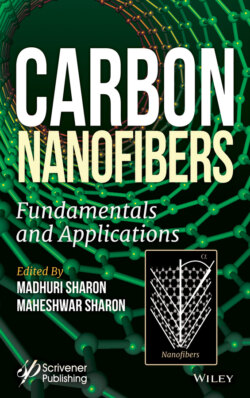Читать книгу Carbon Nanofibers - Группа авторов - Страница 35
1.5 Applications of CNF
ОглавлениеSome of the applications of CNF are enumerated here:
Scientists, after understanding the properties of carbon fibers, have started using this material in various engineering applications to reinforce concrete, replace steel with carbon fibers, as material for bridge work, etc. CNFs are being applied or are thought to apply for strengthening of structures with carbon fiber composites in precast concrete and plastic, and fiber-cement. The traditional method of strengthening the reinforcement of brick is by utilizing steel clamps, which provide strength but also become heavy and are prone to corrosion. CNFs are being thought of to use in place of steel to get almost the same strength. Carbon fibers in precast concrete has also become popular since 2003. Carbon fiber grid reinforcement is applied in the wall panel face, which allows the use of less concrete, reducing weight and raw material.
CNF composites with a conductive polymer, polypyrrole (PPy), in N,N-dimethylformamide (DMF) solvent increases its strength.
The non-corrosive nature of carbon fibers prevents the rusting and staining which otherwise occur with steel reinforcing. Carbon fiber composites have low thermal conductivity, thus reducing the transfer of heat or cold from outside to inside. Carbon fiber composites used for building works provide the benefit from long-term energy savings. CNF is used in bridge construction because CNF-reinforced plastic provides reduction in bridge weight and economy of lifting equipment. Carbon fibers possess the property of repelling water, hence are used by mixing with grits and coal tar to give more life to the road.
CNFs are used as additive for anode and cathode materials in energy conversion and storage systems because they possess properties like good chemical stability, thermal stability, and electrical conductivity, high specific surface area and good charge transport properties.
CNF is used for the delivery of therapeutic drugs. It has been proposed that when a needle-shaped carbon nanofiber is loaded with therapeutic drugs and embedded into an elastic material (which can be inflated to form a balloon) and inserted next to the diseased site, the needle-shaped CNF penetrates the diseased cell and delivers the therapeutic drugs.
Since CNF has large surface area and good electrochemical properties, it is observed that it increases the capacity of lithium battery more than graphite. CNF is used to improve overall energy capacity and cycling stability of anode material of lithium-ion battery. Because of its reversible electrochemical properties, it increases good charging/ discharging cycles of lithium battery. Metal/CNF composites, like carbon/TiO2, Carbon/SnO2, etc., have been found to enhance the capacity of lithium-ion battery.
CNF is used to develop gas mask sensor because it changes its color after absorbing chemical.
Since the electrical conductivity in CNF is highest along its length, it can be used as electron field emitter if aligned CNF is grown along its length.
Supercapacitors (electric double-layer capacitors) are gaining in popularity because they can provide high energy density and better power density than normal batteries. There has been increasing interest in the use of porous carbon nanofibers to develop supercapacitors because of their higher specific surface area (1200 m2/g or more). The electrode (e.g., CNF/V2O5 composite) has given specific capacitance of 150 F/g and energy density of 18.8 W h kg-1 over a power density range of 400–20,000 W kg-1. Number of operating cycles with CNF supercapacitor has also been found in the range of 2000 cycles.
Because of their low-cost, dye-sensitized solar cells (DSSC) are being thought of to replace silicon solar cells. DSSC consists of a photoanode and a counter electrode separated by a redox electrolyte (iodide/triiodide). CNFs are highly stable against electrochemical corrosion in either alkaline or acidic media, hence are found to possess significant catalytic activity and power conversion efficiency in DSCs. This material is expected to replace expensive counter electrode made of noble metals like platinum.
CNF can be used as catalyst due to its high specific surface area, high chemical resistance, outstanding electrical properties, and suitable mechanical properties. Because of good electrical properties, it is developed for high loaded active enzymes and for fast kinetics at electrode surface, especially for enzymatic cathodes in biofuel cell devices. Carbon of CNF acts both as catalyst and adsorbent for the catalytic oxidation of NO into NO2 or reduction of NO into N2.
In developing electrodes for fuel cell, it is essential to replace platinum with some other materials which are inexpensive. CNFs loaded with nickel, iron and nitrogen are found to be suitable material for use as an electrode in alkaline fuel cell.
Microbial fuel cell (MFC) is a bio-electrochemical cell that uses microorganisms to utilize organic substrates at anodes to generate electricity. For this purpose, it is necessary to develop biocompatible electrode materials with high surface area and long-term stability to support the maximum growth of bacteria and enhance electron transfer rate. CNFs are finding their use as anode in MFC [18].
CNFs have generated interest in the area of sensors and biosensors because of their functionalization ability, electrochemical property, mechanical flexibility, and biocompatibility. They have exhibited a good response for developing glucose biosensor. Metal-loaded CNFs are gaining in popularity in developing biosensors. For example, palladium-loaded CNFs exhibit good electrochemical catalytic activities for determining dopamine (DA), uric acid (UA), and ascorbic acid (AA). These three chemicals can be determined simultaneously from their mixture because of their difference in overpotential [19].
CNFs are used as good adsorbent material especially in the field of adsorption/separation because of their high specific surface area and high porosity. Removal of dissolved impurities, such as dyes and metals present in drinking and industrial water, is being tried using CNFs. There are several chapters devoted to different applications of CNF presented in this book.
